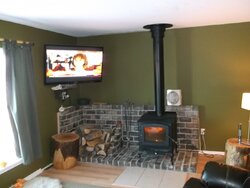- Nov 15, 2012
- 41
Hi Everyone. I'm in the midst of designing a hearth for an Aurora wood stove we recently purchased, and I have a few questions I'm hoping you can help me with. I'm thinking to make both the horizontal pad and the vertical heat shield from brick. So the vertical shield would essentially be a brick wall, with a 1" air space behind it. I'm curious if others have done this? I've read that the top and either the sides or bottom have to be open to promote air movement. Which method have you done and liked or disliked? I'm not sure I'd like how the wall would look with a visible 1" space behind it; but I'm not sure either that I'd feel real good about a freestanding brick wall that doesn't even have a full course of bricks across its bottom. I was thinking you could possibly do something to conceal the gap if you left the sides open; but I'm still working that out.
Thanks a bunch for any thoughts or suggestions.
Thanks a bunch for any thoughts or suggestions.


